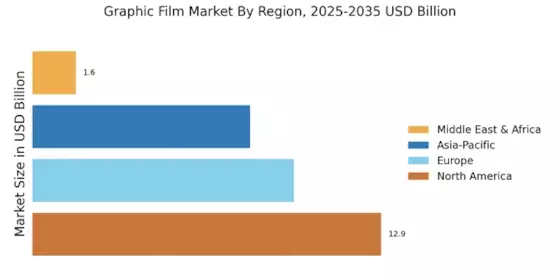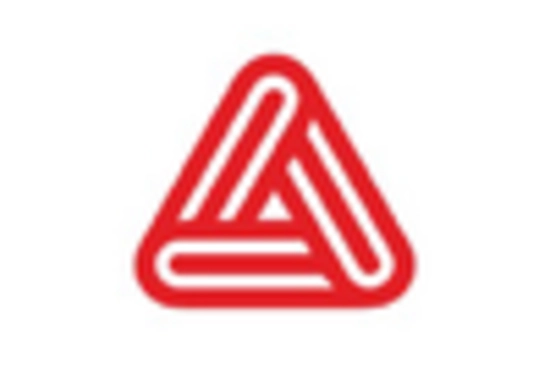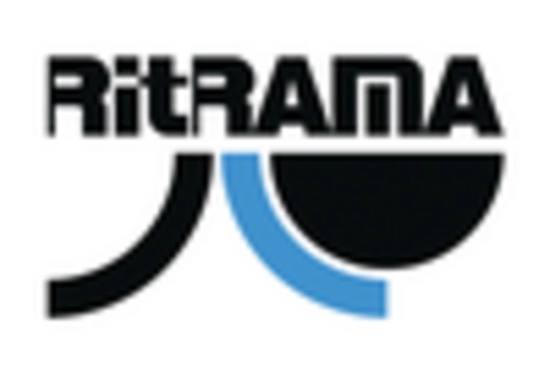Growth in E-commerce and Retail
The Graphic Film Market is significantly influenced by the expansion of e-commerce and retail sectors. As online shopping continues to gain traction, businesses are increasingly utilizing graphic films for packaging and promotional materials. In 2025, the e-commerce sector is expected to account for a substantial portion of retail sales, leading to a heightened demand for visually appealing packaging solutions. Graphic films serve as an effective medium for branding and product differentiation, allowing companies to create memorable unboxing experiences for consumers. This trend is particularly relevant in the food and beverage industry, where packaging aesthetics can influence purchasing decisions. Consequently, the Graphic Film Market is likely to see robust growth as retailers and e-commerce platforms prioritize visually engaging packaging to enhance customer satisfaction and loyalty.
Emergence of Smart Packaging Solutions
The Graphic Film Market is witnessing a transformative shift with the emergence of smart packaging solutions. As consumer preferences evolve, there is a growing demand for packaging that not only serves a functional purpose but also enhances the overall user experience. Smart packaging, which incorporates technology such as QR codes and augmented reality, is becoming increasingly popular among brands looking to engage consumers in innovative ways. In 2025, the market for smart packaging is expected to expand significantly, driving demand for graphic films that can accommodate these technologies. This trend presents a unique opportunity for the Graphic Film Market to innovate and provide solutions that meet the needs of modern consumers, ultimately enhancing brand loyalty and engagement.
Rising Demand for Visual Communication
The Graphic Film Market experiences a notable surge in demand for visual communication solutions. As businesses increasingly recognize the importance of effective branding and advertising, the need for high-quality graphic films becomes paramount. In 2025, the market is projected to reach a valuation of approximately 10 billion USD, driven by the growing emphasis on aesthetics in marketing strategies. Companies are investing in graphic films to enhance their visibility and engage consumers more effectively. This trend is particularly evident in sectors such as retail and automotive, where eye-catching graphics play a crucial role in attracting customers. The Graphic Film Market is thus positioned to benefit from this rising demand, as organizations seek innovative ways to convey their messages and stand out in a competitive landscape.
Technological Innovations in Film Production
Technological advancements play a pivotal role in shaping the Graphic Film Market. Innovations in film production techniques, such as digital printing and eco-friendly materials, are revolutionizing the way graphic films are created and utilized. In 2025, the market is expected to witness a rise in the adoption of advanced printing technologies, which enhance the quality and durability of graphic films. These innovations not only improve the visual appeal of the films but also contribute to sustainability efforts by reducing waste and energy consumption. As businesses increasingly seek to align with environmentally conscious practices, the Graphic Film Market is likely to benefit from the integration of these technologies, enabling companies to produce high-quality films that meet consumer demands for both aesthetics and sustainability.
Increased Investment in Advertising and Marketing
The Graphic Film Market is poised for growth due to increased investment in advertising and marketing initiatives. As companies strive to capture consumer attention in a crowded marketplace, they are allocating more resources to visually impactful advertising strategies. In 2025, advertising expenditures are projected to rise, with a significant portion directed towards outdoor and point-of-sale advertising, where graphic films are extensively used. This trend is particularly pronounced in industries such as fashion and technology, where brand visibility is crucial. The Graphic Film Market stands to gain from this heightened focus on advertising, as businesses seek to leverage graphic films to create compelling visual narratives that resonate with their target audiences.


















Leave a Comment